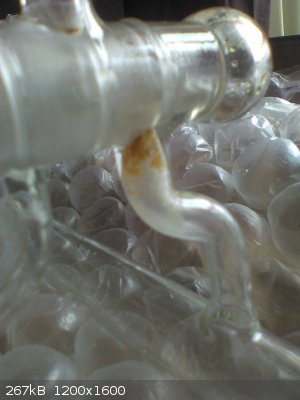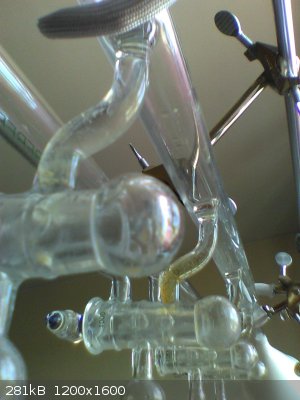Duff
Harmless

Posts: 17
Registered: 10-5-2020
Member Is Offline
|
|
Mysterious orange-brown residue inside used glassware
I bought a used Schlenk line off ebay. It looks great, but it has some residue left inside from the previous owner. See the attached picture. I
messaged the seller on ebay to ask what it might be, and they said they buy their stock from closed labs and auctions, so they have no clue. What sort
of solvent and precautions should I take to clean this?

|
|
|
DraconicAcid
International Hazard
    
Posts: 4278
Registered: 1-2-2013
Location: The tiniest college campus ever....
Member Is Offline
Mood: Semi-victorious.
|
|
It's probably old stopcock grease.
Please remember: "Filtrate" is not a verb.
Write up your lab reports the way your instructor wants them, not the way your ex-instructor wants them.
|
|
|
Sigmatropic
Hazard to Others
  
Posts: 307
Registered: 29-1-2017
Member Is Offline
Mood: No Mood
|
|
Don't inhale or ingest it, avoid skin contact, Clean it in a well ventilated area. Even if it is one of the nasties, it wouldn't harm you if you take,
what I call, normal precautions.
Then again I'm with draconicacid and wouldn't expect any significant amount of nasties in a schlenk line.
[Edited on 22-6-2020 by Sigmatropic]
|
|
|
Tsjerk
International Hazard
    
Posts: 3022
Registered: 20-4-2005
Location: Netherlands
Member Is Offline
Mood: Mood
|
|
I would start with soaking with acetone.
|
|
|
mackolol
Hazard to Others
  
Posts: 458
Registered: 26-10-2017
Member Is Offline
Mood: Funky
|
|
Yeahh.. for sure dont eat it, dont sniff it neither inject it anywhere.
I'm pretty sure whatever it is washing it with sulfuric acid will work, if not try piranha.
|
|
|
SWIM
National Hazard
   
Posts: 970
Registered: 3-9-2017
Member Is Offline
|
|
I've used 10% bleach soaking on a few mystery deposits I didn't want to, or couldn't, get close to.
A few days in a bucket of bleach will eat most things organic.
Or stop up all the apparatus' joints and just fill it (leave a vent hole or loose stopper on top.)
I do try solvents and acid of some sort first, but this is a last resort short of piranha, and fairly cheap to buy at pool supply stores.
But the odds of it being all that dangerous are low.
I'd probably just scrub that out in the garage sink with gloves and wash up after.
I've dealt with a lot of brown to black mystery deposits in used glassware over the years, and I still haven't developed any super powers.
|
|
|
UC235
National Hazard
   
Posts: 565
Registered: 28-12-2014
Member Is Offline
Mood: No Mood
|
|
Quote: Originally posted by SWIM  | I've used 10% bleach soaking on a few mystery deposits I didn't want to, or couldn't, get close to.
A few days in a bucket of bleach will eat most things organic.
Or stop up all the apparatus' joints and just fill it (leave a vent hole or loose stopper on top.)
I do try solvents and acid of some sort first, but this is a last resort short of piranha, and fairly cheap to buy at pool supply stores.
But the odds of it being all that dangerous are low.
I'd probably just scrub that out in the garage sink with gloves and wash up after.
I've dealt with a lot of brown to black mystery deposits in used glassware over the years, and I still haven't developed any super powers.
|
Absolutely do not soak high vacuum glassware in anything vaguely caustic. The stopcocks should be individually paired and to much tighter tolerances
than most stopcocks and you do not want to etch them.
I believe hexanes were the preferred method of removing silicone grease back in school. Feel free to try acetone and ethyl acetate too.
|
|
|
DavidJR
National Hazard
   
Posts: 908
Registered: 1-1-2018
Location: Scotland
Member Is Offline
Mood: Tired
|
|
DCM works well for removing old nasty grease.
|
|
|
SWIM
National Hazard
   
Posts: 970
Registered: 3-9-2017
Member Is Offline
|
|
Quote: Originally posted by UC235  | Quote: Originally posted by SWIM  | I've used 10% bleach soaking on a few mystery deposits I didn't want to, or couldn't, get close to.
A few days in a bucket of bleach will eat most things organic.
Or stop up all the apparatus' joints and just fill it (leave a vent hole or loose stopper on top.)
I do try solvents and acid of some sort first, but this is a last resort short of piranha, and fairly cheap to buy at pool supply stores.
But the odds of it being all that dangerous are low.
I'd probably just scrub that out in the garage sink with gloves and wash up after.
I've dealt with a lot of brown to black mystery deposits in used glassware over the years, and I still haven't developed any super powers.
|
Absolutely do not soak high vacuum glassware in anything vaguely caustic. The stopcocks should be individually paired and to much tighter tolerances
than most stopcocks and you do not want to etch them.
I believe hexanes were the preferred method of removing silicone grease back in school. Feel free to try acetone and ethyl acetate too.
|
Bleach etches glass?
Never heard that before.
Also, if a high vacuum valve needs a matched core, the are high vacuum valve bodies without their cores no longer suitable for high vacuum work?
How can a matched core be replaced?
I thought a high vacuum valve was merely a valve with a covered small end so the vacuum ensured strong valve seating.
|
|
|
Duff
Harmless

Posts: 17
Registered: 10-5-2020
Member Is Offline
|
|
Ok, so I set up the Schlenk line at a little bit of an angle, and then put a stopper at the lower end, on the side with the residue. Then I used a
funnel with a tube to pour acetone down the line until the dirty tubes were filled up. I'm going to let it soak for a while, then I'll place a bucket
below and pump in water to rinse it out. How long do you figure I should let it soak?

[Edited on 4-7-2020 by Duff]
|
|
|